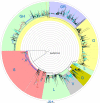Comprehensive Genome Analysis of 6,000 USA SARS-CoV-2 Isolates Reveals Haplotype Signatures and Localized Transmission Patterns by State and by Country
- PMID: 33013809
- PMCID: PMC7509426
- DOI: 10.3389/fmicb.2020.573430
Comprehensive Genome Analysis of 6,000 USA SARS-CoV-2 Isolates Reveals Haplotype Signatures and Localized Transmission Patterns by State and by Country
Abstract
Genomic analysis of SARS-CoV-2 sequences is crucial in determining the effectiveness of prudent safer at home measures in the United States (US). By haplotype analysis of 6,356 US isolates, we identified a pattern of strongly localized outbreaks at the city-, state-, and country-levels, and temporal transmissions. This points to the effectiveness of existing travel restriction policies and public health measures in reducing the transmission of SARS-CoV-2.
Keywords: COVID-19; SARS-CoV-2; haplotype; localized outbreak; temporal transmission; variant.
Copyright © 2020 Shen, Dien Bard, Biegel, Judkins and Gai.
Figures

Similar articles
-
Dynamic Public Health Surveillance to Track and Mitigate the US COVID-19 Epidemic: Longitudinal Trend Analysis Study.J Med Internet Res. 2020 Dec 3;22(12):e24286. doi: 10.2196/24286. J Med Internet Res. 2020. PMID: 33216726 Free PMC article.
-
Genomic analysis of early transmissibility assessment of the D614G mutant strain of SARS-CoV-2 in travelers returning to Taiwan from the United States of America.PeerJ. 2021 Sep 2;9:e11991. doi: 10.7717/peerj.11991. eCollection 2021. PeerJ. 2021. PMID: 34557346 Free PMC article.
-
Genomic Analysis of Early SARS-CoV-2 Variants Introduced in Mexico.J Virol. 2020 Aug 31;94(18):e01056-20. doi: 10.1128/JVI.01056-20. Print 2020 Aug 31. J Virol. 2020. PMID: 32641486 Free PMC article.
-
Quarantine alone or in combination with other public health measures to control COVID-19: a rapid review.Cochrane Database Syst Rev. 2020 Sep 15;9(9):CD013574. doi: 10.1002/14651858.CD013574.pub2. Cochrane Database Syst Rev. 2020. PMID: 33959956 Free PMC article.
-
Travel-related control measures to contain the COVID-19 pandemic: a rapid review.Cochrane Database Syst Rev. 2020 Oct 5;10:CD013717. doi: 10.1002/14651858.CD013717. Cochrane Database Syst Rev. 2020. Update in: Cochrane Database Syst Rev. 2021 Mar 25;3:CD013717. doi: 10.1002/14651858.CD013717.pub2. PMID: 33502002 Updated.
Cited by
-
A predictive model of perceived stress during the first wave of the COVID-19 pandemic in university students Ecuadorians.Front Psychiatry. 2023 Jul 13;14:1202625. doi: 10.3389/fpsyt.2023.1202625. eCollection 2023. Front Psychiatry. 2023. PMID: 37520229 Free PMC article.
-
Genomic variation, origin tracing, and vaccine development of SARS-CoV-2: A systematic review.Innovation (Camb). 2021 May 28;2(2):100116. doi: 10.1016/j.xinn.2021.100116. Epub 2021 May 11. Innovation (Camb). 2021. PMID: 33997827 Free PMC article. Review.
-
Emerging variants of concern in SARS-CoV-2 membrane protein: a highly conserved target with potential pathological and therapeutic implications.Emerg Microbes Infect. 2021 Dec;10(1):885-893. doi: 10.1080/22221751.2021.1922097. Emerg Microbes Infect. 2021. PMID: 33896413 Free PMC article.
-
High Prevalence of SARS-CoV-2 Genetic Variation and D614G Mutation in Pediatric Patients With COVID-19.Open Forum Infect Dis. 2020 Nov 13;8(6):ofaa551. doi: 10.1093/ofid/ofaa551. eCollection 2021 Jun. Open Forum Infect Dis. 2020. PMID: 34095334 Free PMC article.
-
Rapidly emerging SARS-CoV-2 B.1.1.7 sub-lineage in the United States of America with spike protein D178H and membrane protein V70L mutations.Emerg Microbes Infect. 2021 Dec;10(1):1293-1299. doi: 10.1080/22221751.2021.1943540. Emerg Microbes Infect. 2021. PMID: 34125658 Free PMC article.
References
-
- Korber B., Fischer W. M., Gnanakaran S., Yoon H., Theiler J., Abfalterer W., et al. (2020). Spike mutation pipeline reveals the emergence of a more transmissible form of SARS-CoV-2. bioRxiv [Preprint], 10.1101/2020.04.29.069054 - DOI
-
- Shen L., Maglinte D., Ostrow D., Pandey U., Bootwalla M., Ryutov A., et al. (2020b). Children’s hospital los angeles COVID-19 analysis research database (CARD) - A resource for rapid SARS-CoV-2 genome identification using interactive online phylogenetic tools. bioRxiv [Preprint], 10.1101/2020.05.11.089763 - DOI
LinkOut - more resources
Full Text Sources
Miscellaneous

